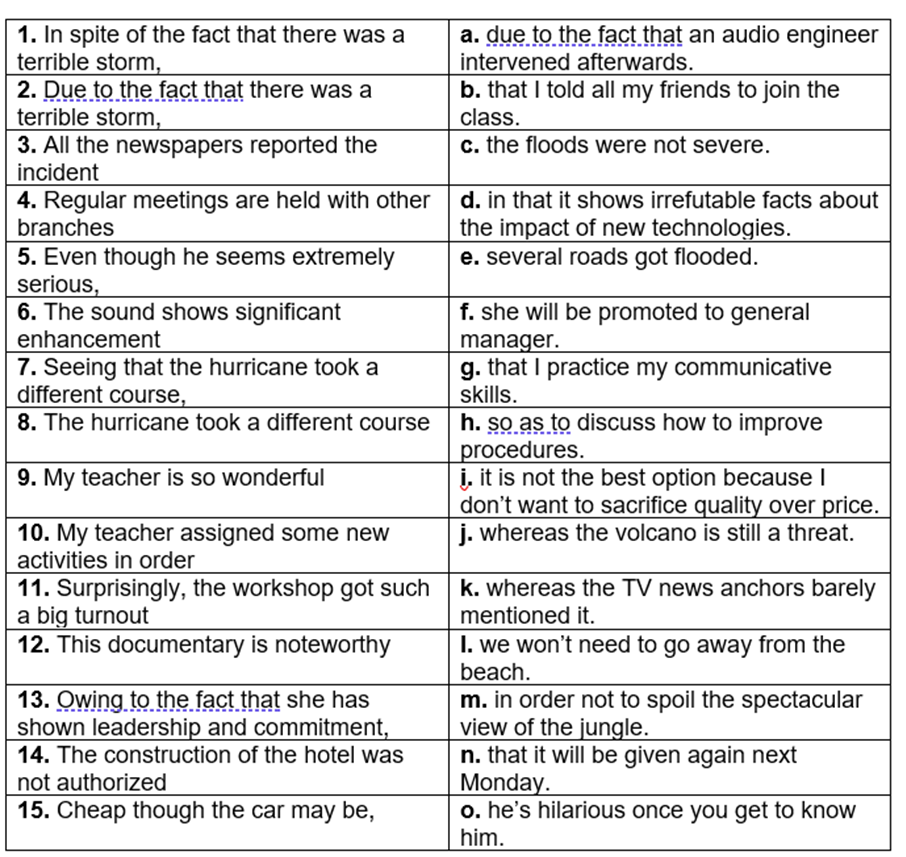I. WHAT IS A CLAUSE?
A clause is a unit of words in a sentence which contains a subject and a verb, or at least a verb:
I am exhausted [clause 1] because I ran a marathon [clause 2].
The type of clause depends on what it expresses. For example, clause 2 gives a reason. Besides reason, clauses can express contrast, purpose, and result.
II. RECOGNIZING CLAUSES IN THEORY
2.1. CLAUSES OF CONTRAST

2.1.1. We can express a direct contrast between two ideas or situations, using whereas or while:
My father commutes to work by train, whereas/while I go on foot.
2.1.2. We can show a surprising contrast between the two clauses, which expresses an unexpected result, using although, even though, despite the fact, in spite of the fact:
- Although/Even though the dish was too spicy, I managed to eat it all.
- Despite the fact/In spite of the fact that the film is terrible, it was the biggest box office success of the year.
In order to emphasize an adjective in a clause of contrast, follow this pattern:
[adjective + though + subject + (linking) verb]
Embarrassed though I was feeling, I kept singing in front of the audience.

2.2. CLAUSES OF PURPOSE
2.2.1. We can express the objective of an action using in order to or so as to:
The company is launching a campaign in order to/so as to increase sales.
If the purpose is to prevent something from happening, we use in order not to or so as not to:
The firm fired that lawyer in order not to/so as not to damage its reputation.
Notice that these clauses of purpose do not have a noun or pronoun. They only follow the pattern [in order/so as + (not) to + verb]
2.2.2. If we want to mention a noun or a pronoun in the clause of purpose, we use so that or in order that:
I am renting an apartment near my school so that/in order that I get there more quickly.

2.3. CLAUSES OF REASON
2.3.1. We can express why something occurs using because, since, as, because of the fact that, due to the fact that, on account of the fact that, owing to the fact that, or seeing that:
- This institution offers excellent services since/as/because it receives a large budget from the government.
- Because of the fact that/Due to the fact that/On account of the fact that/Owing to the fact that/Seeing that the plan was not working, the committee decided to change the strategy.
Note that there is no comma when the clause of reason appears in second place as in the first example. The second example shows that there is a comma after the clause of reason because it is at the beginning.
2.3.2. To express a reason more formally, we can use for (preceded by a comma):
Urban planning must be a priority, for our well-being is at stake.
2.3.3. In formal contexts, if we want to give reasons to prove that what we mentioned is true, we use in that or inasmuch as:
The movie is an immersive experience in that/inasmuch as it appeals to all the senses.

2.4. CLAUSES OF RESULT
2.4.1. We can express a result by means of a noun that has a particular quality. The structure of the clause is:
[such/such a(n) + noun phrase (adjective-noun) + that + result]
- It is such good cheese that it is not very cheap.
- They are such a nice family that everybody loves them.
Notice that choosing such or such a depends on whether the noun is uncountable or countable.
2.4.2. We can omit the noun and express a result only considering a characteristic. The structure of the clause is:
[so + adjective + that + result]
She is so talented that she will win the contest.
2.4.3. We can express the result of an action. The pattern is:
[so + adverb + that + result]
The orchestra played so emotionally that I cried.
III. CONSOLIDATION I.
IV. CONSOLIDATION II.
V. EXERCISE I.
Match the columns to join the clauses that go together.

VI. READING TEXT
How Schools Brought Community Together, Even While Apart

Had you tried to devise a situation that would bring our public schools to the brink, you couldn’t have done better than imagining what happened in the spring of 2020. It happened so fast. Suddenly, schools had to figure out how to teach students from afar, without the aid of summer planning or extra training. High schools navigated a doubly difficult challenge: balancing teaching teens in the moment while also ensuring they remained on track for the future amid rising anxiety, stress, and depression.
Experts warned that the pandemic would have a dire impact on generation COVID and early data suggests they may be right. Since the pandemic struck, more than a quarter-million fewer seniors completed financial aid forms that support affordable college enrollment. The greatest declines came from the students who likely need aid the most — students of color and students from low-income backgrounds.
Even against this bleak backdrop, some high schools managed to shine. The College Success Award identifies high schools that support student college enrollment and success in 25 states. This year, GreatSchools reached out to the most exceptional of these winning schools to learn about how they had navigated pandemic education.
Not only did they meet the moment head on, but they devised solutions that worked so well that they made them permanent even after schools returned in the fall. Here’s what they discovered.
Meeting families where they are. Due to the fact that buildings were closed, schools had to get creative about engaging families. El Paso’s Valle Verde Early College High School, for example, took its monthly parent forums online and discovered what happens when you remove barriers to family engagement. At the first meeting, instead of 50 parents, over 300 showed up and crashed the system. "We see people making dinner, doing laundry, but listening and asking questions. They’re taking care of life responsibilities," says recently-retired Principal Paul Covey. With the simple click of a button, hundreds of multitasking parents were given the opportunity to participate in school activities without having to find childcare, leave work early, or take public transportation.
Meeting alumni where they are. Florida’s Mater Performing Arts Academy had always invited alumni to visit the school so as to share their experiences, but once school was online, they discovered that they could access alumni all over the country. "We’re doing a lot of presentations with our alumni who are in Boston, or in San Francisco," says college counseling lead Silvino Macho. By leveraging the power of video conferencing, the school engaged its alumni community to share their college and career lessons and mentor students.
Meeting teens where they are. Owing to the fact that schools went virtual, teacher Scott Frank took it as a chance to speak teens’ language. He created online videos of core topics in his history classes at IDEA Frontier College Prep in Brownsville, TX. Frank’s YouTube channel became an evergreen bank students could reference while studying or doing homework. His biology counterpart made short videos on TikTok and awarded bonus points to students that watched. For these teachers, the language of social media became a friend request they gladly accepted.
VII. PRACTICE I
VIII. BIBLIOGRAPHY
Azar, B. S. (2002). Understanding and Using English Grammar (Third Edition). Longman
Hewings, M. (2005). Advanced Grammar in Use book with answers: A Self-Study Reference and Practice Book for Advanced Learners of English (Second Edition). Cambridge University Press.
Hewings, M. (2009). Grammar for CAE and Proficiency with answers; self-study grammar reference and practice. Cambridge University Press.
Norris, R., & French, A. (2008). Ready for CAE. Macmillan Publishers.
Side, R., & Wellman, G. (2002). Grammar and Vocabulary for Cambridge Advanced and Proficiency. Longman.
IX. WEB RESOURCES.
Image 1. Free stock photos_ https://www.pexels.com/es-es/foto/lapices-de-colores-amarillo-y-azul-1762851/ Photo by Ann H from Pexels
Image 2. Free stock photos_ https://www.pexels.com/photo/colorful-cutouts-of-the-word-purpose-4116640/Photo by Magda Ehlers from Pexels.
Image 3. Free stock photos_ https://www.pexels.com/photo/handwritten-sand-dirty-sign-11022633/ Photo by Ann H from Pexels
Image 4. Free stock photos_ https://www.pexels.com/photo/three-brown-tiles-on-gray-surface-1154775/ Photo by Susanne Jutzeler from Pexels
X. CREDITS
Practice exercise written by Ismael Centeno Leos_Licenciatura en Enseñanza de Inglés at FES ACATLÁN UNAM
Audio version performed by Matthew_Voicemaker_Text to Speech Converter_Ismael Centeno 2022 Subscription
Article by NewsUSA. Published September 23rd, 2021. Text retrieved and adapted from_https://www.copyrightfreecontent.com/education/how-schools-brought-community-together-even-while-apart/
Practice exercise written by Ismael Centeno Leos_Licenciatura en Enseñanza de Inglés at FES ACATLÁN UNAM
Audio version performed by Kimberly_Voicemaker_Text to Speech Converter
Free stock photos_ https://www.pexels.com/es-es/foto/mujer-ordenador-portatil-macbook-pro-oficina-4064176/ Photo by Marcus Aurelius from Pexels